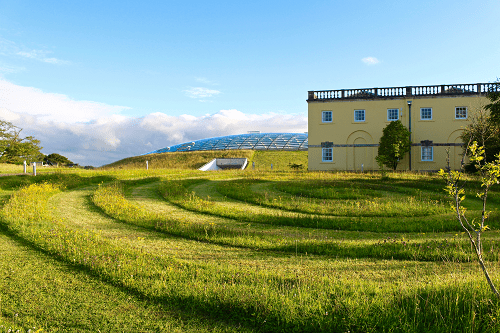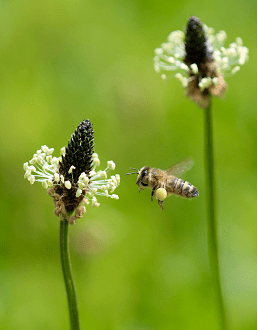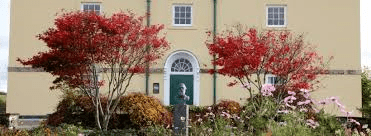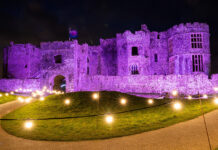New project for the Well-being of the People, Wildlife and Environment of  Wales
Wales
An exciting £1.3 million project that promises to boost the well-being of Welsh people, plants and pollinators has been given the green light.
‘Biophilic Wales’ is being led by the National Botanic Garden of Wales and funded by Welsh Government’s Enabling Natural Resources and Well-being Grant. The main delivery partners in the project are Swansea Bay University Health Board, Natural Resources Wales and Swansea University.
The overall aim of Biophilic Wales is to increase the well-being of people, biodiversity and the environment, throughout Wales, using three interconnected work packages: Inspiring Spaces, Grasslands for Life and Plants for People.
It will result in:
- the ‘greening’ of vital, outdoor spaces, in places where people can benefit from them the most;
- the protection and improvement of our most beautiful grassland landscapes; and
- the celebration of Wales’ natural heritage by protecting some of our most endangered plants.
Top of the project’s hit-list are sites surrounding hospitals, health-centres and mental health facilities, run by Swansea Bay University Health Board – one of the key partners in the project. The Botanic Garden’s Head of Science and Biophilic Wales lead, Dr Natasha de Vere, said: “We will increase access, biodiversity value and create vital wildlife habitats. We will create inspirational green spaces for people to connect with and benefit from the natural environment. The work we do will be used to develop models that can be applied throughout Wales.”
As Chair of Swansea University Health Board, Professor Andrew Davies has been one of the key figures behind the project. Professor Davies, who has recently retired from the role, said: “I am delighted with this news, which has grown out of the unique partnership created between Swansea Bay University Health Board and the National Botanic Garden Wales.
“It will bring huge benefits to the well-being of patients and staff, as well as the wider communities, through an increased engagement with the natural world.
“As the first health board in Wales to be awarded Green Flag status, Swansea Bay is very committed to working with nature and developing green infrastructure on its land and many sites, including its hospitals.
“It is well known that engaging with the natural environment helps improve people’s well-being, their quality of life and also helps recovery after illness.”
The ‘Inspiring Spaces’ element of the project will see a transformation of under-used outdoor areas into spaces that are full of wildlife, where people can enjoy and be restored by the natural world.
An army of community groups and volunteers will be recruited to deliver this and all aspects of the work – and they will continue to champion the cause after the project is finished.
Under the heading of ‘Grasslands For Life’, Dr Andrew Lucas, of Natural Resources Wales, says: “This project will revolutionise how we monitor grasslands, enabling us to manage, restore and create sites that maximise biodiversity and ecosystem resilience. We will use innovative soil DNA barcoding to determine the entire biosphere of grasslands, including plants, animals, fungi and microbes.”
This part of the project will focus on grasslands throughout Wales, ranging from amenity grasslands within the Swansea Bay University Health Board estate, colliery spoil sites, to conservation grasslands in national nature reserves all over Wales.
The final component – ‘Plants For People’ – will be a celebration of Wales’ natural plant heritage.
Dr de Vere said: “We will ensure that our nation’s most threatened plants and key grassland species are protected for the future by collecting seed for the National Seed Bank of Wales. We will develop approaches to ensure that Welsh-provenance seed of grassland species is available for restoration and creation projects in the future.
“This exciting project is core to the delivery of the Botanic Garden’s mission. In particular, it emphasises the social role of the Garden and further increases its contribution to the delivery of the Well-being of Future Generations Act.”
Minister for Environment, Energy and Rural Affairs, Lesley Griffiths, said: “This project will make a major contribution to maintaining and enhancing biodiversity through collaboration between Wales’ public bodies, communities and world-class academics. It will also benefit the physical and mental well-being of our communities through increasing access to nature-rich green spaces”.
“This is exactly the kind of collective action needed to tackle the ecological emergency affecting Wales’ most precious species and habitats and shows how the intentions of the Well-being of Future Generations Act are being realised on the ground.”
Prosiect llesiant ysbrydoledig yn falm i’r enaid
Mae prosiect newydd gwerth £1.3 miliwn, sy’n debygol o hybu lles pobl, planhigion a pheillwyr Cymru, wedi cael sêl bendith.
 Mae ‘Caru Natur Cymru’ yn cael ei arwain gan Ardd Fotaneg Genedlaethol Cymru a’i ariannu gan Grant Galluogi Adnoddau Naturiol a Llesiant Llywodraeth Cymru. Prif bartneriaid cyflenwi’r prosiect yw Bwrdd Iechyd Prifysgol Bae Abertawe, Cyfoeth Naturiol Cymru a Phrifysgol Abertawe.
Mae ‘Caru Natur Cymru’ yn cael ei arwain gan Ardd Fotaneg Genedlaethol Cymru a’i ariannu gan Grant Galluogi Adnoddau Naturiol a Llesiant Llywodraeth Cymru. Prif bartneriaid cyflenwi’r prosiect yw Bwrdd Iechyd Prifysgol Bae Abertawe, Cyfoeth Naturiol Cymru a Phrifysgol Abertawe.
Nod gyffredinol Caru Natur Cymru yw cynyddu llesiant pobl, bioamrywiaeth a’r amgylchedd, a hynny ledled Cymru, gan ddefnyddio tri phecyn gwaith cydgysylltiedig: Mannau Ysbrydoledig, Glaswelltiroedd am Oes a Phlanhigion ar gyfer Pobl.
Bydd yn arwain at y canlynol:
- ‘glasu’ lleoedd hanfodol yn yr awyr agored, a hynny mewn mannau lle gall pobl gael y budd mwyaf ohonynt;
- amddiffyn a gwella ein tirluniau glaswelltir mwyaf prydferth; a
- dathlu treftadaeth naturiol Cymru trwy amddiffyn y planhigion hynny sydd fwyaf mewn perygl yng Nghymru.
Ar frig rhestr weithredu’r prosiect y mae safleoedd sy’n amgylchynu ysbytai, canolfannau iechyd a chyfleusterau iechyd meddwl, a gynhelir gan Fwrdd Iechyd Prifysgol Bae Abertawe – un o’r partneriaid allweddol yn y prosiect.
Dywedodd Pennaeth Gwyddoniaeth yr Ardd Fotaneg ac arweinydd Caru Natur Cymru, Dr Natasha de Vere: “Byddwn yn cynyddu’r hygyrchedd, ynghyd â’r gwerth o ran bioamrywiaeth, ac yn creu cynefinoedd bywyd gwyllt hanfodol. Byddwn yn creu mannau gwyrdd ysbrydoledig i bobl gysylltu â’r amgylchedd naturiol a chael budd ohono. Bydd yr hyn a wnawn yn cael ei ddefnyddio i ddatblygu modelau y gellir eu rhoi ar waith ledled Cymru.”
Ac yntau’n Gadeirydd Bwrdd Iechyd Prifysgol Abertawe, bu’r Athro Andrew Davies yn un o’r ffigurau allweddol y tu ôl i’r prosiect. Dywedodd yr Athro Davies, a ymddeolodd o’r rôl yn ddiweddar: “Rwyf wrth fy modd â’r newyddion hwn, sydd wedi datblygu o bartneriaeth unigryw a grëwyd rhwng Bwrdd Iechyd Prifysgol Bae Abertawe a Gardd Fotaneg Genedlaethol Cymru.
“Bydd yn sicrhau manteision enfawr i lesiant cleifion a staff, yn ogystal ag i’r cymunedau ehangach, a hynny trwy ymgysylltu mwy â byd natur.
“Fel y bwrdd iechyd cyntaf yng Nghymru i ennill statws y Faner Werdd, mae Bae Abertawe wedi ymrwymo’n llwyr i weithio gyda natur a datblygu seilwaith gwyrdd ar ei dir a’i safleoedd niferus, gan gynnwys ei ysbytai.
“Mae’n hysbys i bawb fod ymgysylltu â’r amgylchedd naturiol yn helpu i wella llesiant pobl ac ansawdd eu bywyd, a hefyd yn helpu iddynt wella yn dilyn salwch.”
Bydd elfen ‘Mannau Ysbrydoledig’ y prosiect yn sicrhau bod ardaloedd awyr agored nad ydynt yn cael eu defnyddio i’r eithaf yn cael eu trawsnewid yn fannau sy’n llawn bywyd gwyllt, lle gall pobl fwynhau a chael adferiad gan fyd natur.
Bydd byddin o grwpiau cymunedol a gwirfoddolwyr yn cael eu recriwtio i gyflawni hyn, ynghyd â phob agwedd ar y gwaith – a byddant yn parhau i hyrwyddo’r achos wedi i’r prosiect ddod i ben.
O dan y pennawd ‘Glaswelltiroedd am Oes’, dywedodd Dr Andrew Lucas o CNC: “Bydd y prosiect hwn yn chwyldroi’r modd yr ydym yn monitro glaswelltiroedd, ac yn ein galluogi i reoli, adfer a chreu safleoedd sy’n hyrwyddo bioamrywiaeth a gwytnwch ecosystemau. Byddwn yn defnyddio codau bar DNA pridd arloesol i bennu’r biosffer cyfan o laswelltiroedd, gan gynnwys planhigion, anifeiliaid, ffyngau a microbau.”
Bydd y rhan hon o’r prosiect yn canolbwyntio ar laswelltiroedd ledled Cymru, gan amrywio o laswelltir amwynder yn ystad Bwrdd Iechyd Prifysgol Bae Abertawe a safleoedd gwastraff pyllau glo, i laswelltir cadwraeth mewn Gwarchodfeydd Natur Cenedlaethol ym mhob cwr o Gymru.
Bydd y gydran olaf – ‘Planhigion ar gyfer Pobl’ – yn ddathliad o dreftadaeth planhigion naturiol Cymru.
Dywedodd Dr de Vere: “Byddwn yn sicrhau bod y planhigion sydd yn y perygl mwyaf, ynghyd â rhywogaethau glaswelltir allweddol, yn cael eu diogelu ar gyfer y dyfodol trwy fynd ati i gasglu hadau ar gyfer Banc Hadau Cenedlaethol Cymru. Byddwn yn datblygu dulliau i sicrhau bod hadau rhywogaethau glaswelltir sy’n tarddu o Gymru ar gael ar gyfer prosiectau adfer a chreu yn y dyfodol.”
“Mae’r prosiect cyffrous hwn yn greiddiol i gyflawni cenhadaeth yr Ardd Fotaneg. Yn arbennig, mae’n pwysleisio rôl gymdeithasol yr Ardd ac yn cynyddu ei chyfraniad at y gwaith o gyflawni Deddf Llesiant Cenedlaethau’r Dyfodol.”
Dywedodd y Gweinidog dros yr Amgylchedd, Ynni a Materion Gwledig, Lesley Griffiths: “Bydd y prosiect hwn yn cyfrannu’n helaeth at y gwaith o gynnal a gwella bioamrywiaeth trwy gydweithrediad rhwng cyrff cyhoeddus Cymru, cymunedau ac academyddion sy’n arwain y byd. Bydd hefyd yn fuddiol i les corfforol a meddyliol ein cymunedau trwy gynyddu hygyrchedd mannau gwyrdd sy’n gyfoethog mewn natur”.
“Dyma’r union fath o weithgarwch ar y cyd y mae ei angen i fynd i’r afael â’r argyfwng ecolegol sy’n effeithio ar rywogaethau a chynefinoedd mwyaf gwerthfawr Cymru, ac mae’n dangos sut y mae amcanion Deddf Llesiant Cenedlaethau’r Dyfodol yn cael eu gwireddu ar lawr gwlad.”
Help keep news FREE for our readers
Supporting your local community newspaper/online news outlet is crucial now more than ever. If you believe in independent journalism, then consider making a valuable contribution by making a one-time or monthly donation. We operate in rural areas where providing unbiased news can be challenging. Read More About Supporting The West Wales Chronicle





















